Whoever said “All roads lead to Rome…” must have been a Roman – not a Florentine. A trip to Italia is not complete without a visit to Firenze, the cradle of Renaissance art and architecture. Museums and galleries overflow with the work of one time “locals” – names like Michelangelo, daVinci, Donatello and Botticelli. It is so amazing. I just returned from another visit to Firenze and was even more amazed than on my previous visits.
What is it that made this trip that much more exciting than previous ones?
First of all, I only stayed in Florence. I did not try to tour three cities in one 9-day trip as in the past. There is so much to see in this fascinating city and I will return to continue my love affair with it.
We stayed at the Four Seasons Firenze. Located outside of Florence’s historic center, it is set amidst one of the oldest, largest and most beautiful gardens in the city, Giardino della Gherardesca.
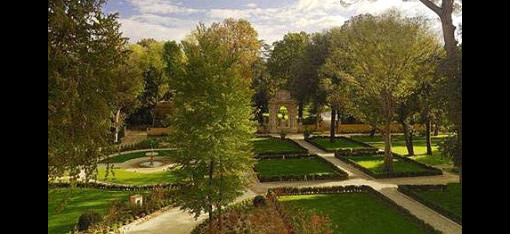
The 11 acres features ancient towering trees scattered with seating areas and superb sculptures – some new, some centuries old. And the buildings situated there are even more handsome. After seven years of renovation, the 15th-century Palazzo della Gherardesca and the 16th century Conventino are now the home of the new Four Seasons Hotel Firenze. Commissioned in 1473 by Bartolomeo Scala, chancellor to Florence’s legendary Medici family, the palazzo was later the residence of Cardinal Alessandro de Medici, who became Pope Leo XI.
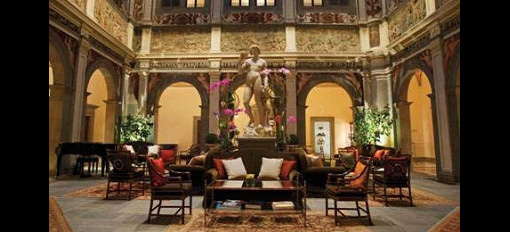
An arcaded courtyard is decorated with 16th-century frescos by Flemish mannerist Jan van der Straet (also known as Giovanni Stradano). There are other Stradano frescos in what was once the palazzo chapel and on the staircase that ascends to the grand suites of the piano nobile. The hotel features other museum quality baroque wonders, including original Florentine art and craftsmanship found in the hotel’s bedrooms, suites and bathrooms. All this and the spectacular service made the Palazzo a very special place to call home.
Second, and perhaps even more important, were our tour guides. Adagio con Brio Management provided us with two of the most informed and passionate licensed guides who customized three different private tours for us. Each was so spectacular that they left many of us in tears.
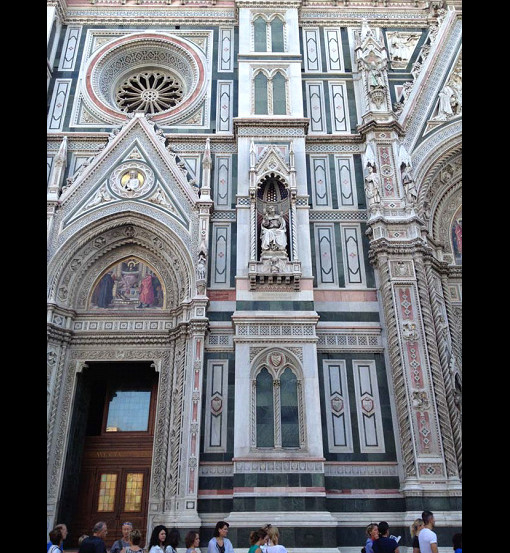
Green, pink and white marble panels comprise the Gothic Revival façade of The Basilica di Santa Maria del Fiore (St. Mary of the Flower), the city’s main church (also called Il Duomo di Firenze). The wealth and prosperity of Florence is obvious in the intentionally elaborate exterior, while the relative bareness of its vast interior corresponds with the austerity of religious life. While the basic structure was completed in 1436, the façade was built in the late 19th century. It remains one of Italy’s largest churches.
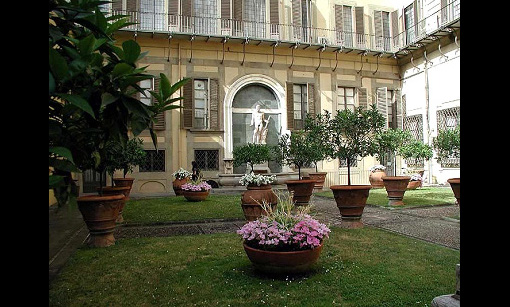
During the 14th to 16th centuries, the financially powerful Medici family ruled the city, bringing it to prominence as they encouraged and attracted the era’s rising contemporary artists. In fact when Lorenzo de Medici, considered the city’s greatest patron, lived in the Palazzo Medici, he invited a young Michelangelo to move in while developing his art expertise. Today sculptures and orange trees fill the palace courtyard garden.
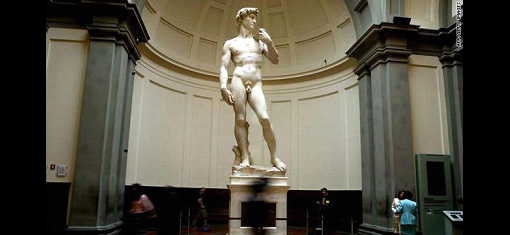
Of course, everyone goes to see the David – both the original at the Academia and the copy outside of the Uffizi Gallery. But did you know Michelangelo made quite the political statement while carving away at the block of marble that became one of the most recognizable works of art of all times? David was the biblical “David” who slew Goliath; the Medici’s commissioned this piece for the top of the Duomo. But in his acceptance of this project – Michelangelo created David to represent the people who were to slay the Medici family. They had abolished democratic rule in Florence and therefore became the giants. When he finished this majestic work of art – he left Florence – the city he loved – and never returned. The people of Florence did not have to slay the Medici’s because the siblings murdered one another and destroyed their dynasty forever. There are no descendants of the Medici family today.
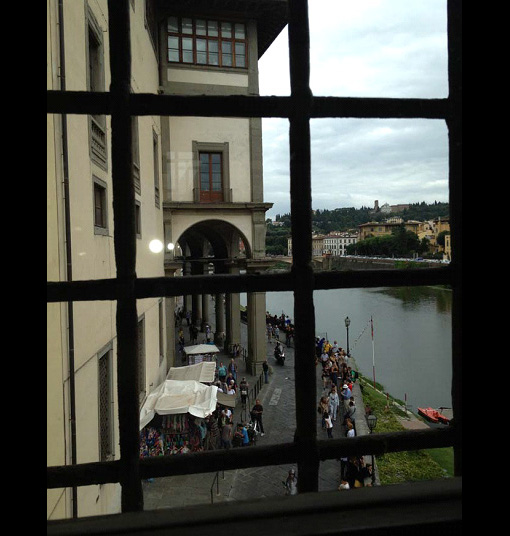
The Vasari Corridor is one of Florence’s best kept secrets or was until Dan Brown featured it in his latest novel Inferno. Rarely open to the public, this aerial walkway was built in five months in 1564 by order of Grand Duke Cosimo de Medici just in time for his son’s wedding. (What parents won’t do for their children’s wedding!) It is an elevated path that allowed the royal family to move freely and unobserved from their residence at Pitti Palazzo to the government palace on the other side of the Arno River.
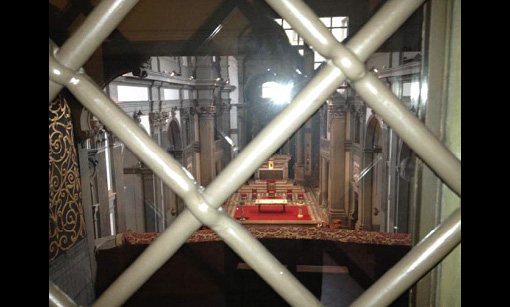
Hidden between houses and other buildings, and passing right through a church, this was my favorite view during a private VIP tour. The passage allowed the Medicis to sneak to Mass without being observed by the public – an enviable position when it is difficult to tell friends from enemies.
By the way, the Corridor is lined with an amazing collection of artistic treasure. What else would one expect of the Medici’s Florence?
All of Florence’s historic center is part of UNESCO’s World Heritage site. If you have not been, I certainly recommend you include it in an upcoming travel itinerary.
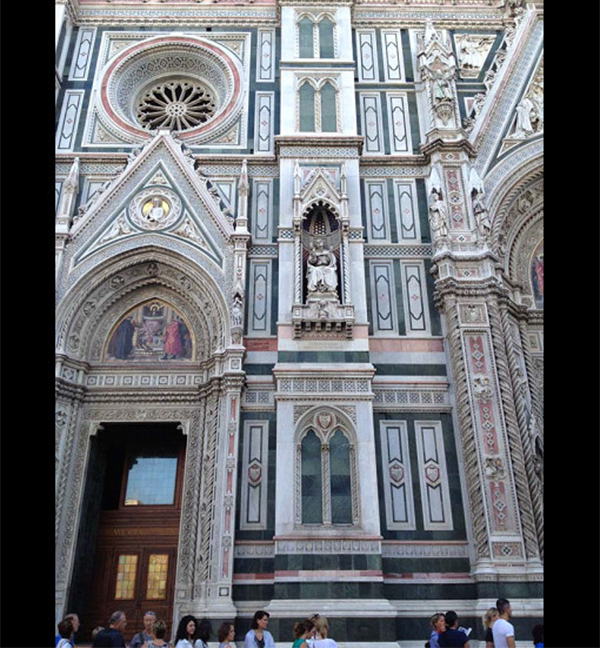
There are 16 comments
Bravo, John.
Great blog. Thank you for sharing the beauty.
Bobbie Volman, Executive Assistant to the Chairman/CEO
MMRGlobal, Inc
great reportage !
I luv Firenze, too 🙂 I was there last Xmas.
ciao
John,
Thank you for sharing. I love it! Will flag and return to the photos for months to come.
Need to put it on our wish list and just do it! I just do not take the time to travel like
I should.
Best,
Frank
John,
I haven’t been back to Florence in quite a few years, and your travel letter brings back fond memories. It also whets my appetite to plan another trip there! Too many people think “more is better” when they plan these packed travel schedules where you spend most of your time at airports.I agree that it’s much more pleasant to stay in one city and avoid the “if it’s Tuesday, this must be Belgium” syndrome. Several years ago I booked a hotel in London for 10-days, and it was one of the most enjoyable trips I ever made. We spent several days in London shopping, going to theaters and restaurants. Then we used our rail pass taking day trips to explore Bath (where we watched the filming of a historical drama), York, Cambridge, and scenic parts of the English countryside tourists usually miss. It was off the beaten path, and took us to places most tourists never get to see.
Keep your world beautiful!
Eve
Oh, what a trip, what a tour, what a life you have!! I enjoyed in every photo and every word you wrote. If you have more photos to share, would love to see!!
Ana & Darko
John,
Thanks for the cool blog. I have only been to Italy once – about fifteen years ago I flew into Rome, went down the Amalfi Coast and on to Sicily. I have to concur that the Italians are amazing Architects and Builders. They are also great ship and boat builders.
Thanks again for taking the time and sharing your blog.
All the best….
Gary Leopardo
Dear John.
I just finished reading the story about your last trip to Florence.
I have tears in my eyes.
I was so happy to see some pictures of my hometown, which I so rarely get to visit (the ticket is so expensive….).
You made me want to leave tomorrow to see my family.
I was really moved by seeing that an American has fully captured the magic and history and charm of my beautiful Firenze.
Grazie. Thank you for sharing.
Fulvia S.
What a nice article. Thank you for sharing.
I trust you had a fabulous trip.
Melody
Melody W Earnheart
AMERICAN EXPRESS TRAVEL
John! What fun!!! thanks for this very informative personal “tour!!!!”
NANCY JOYCE, BROKER
Top 1%, Chicago Association of Realtors
KOENIG & STREY REAL LIVING
Fabulous travelogue !! I love Firenze. When I was 19 I lived
there for 1 month. Pure heaven.
also been back several times later.
Hope you are well !!!!
XXXX
Marilyn
Amazing.
Hi John
your post is just GREAT! Thank you very much for your nice words about Adagio con Brio Management! Let me stress again that we all were delighted to work with your nice group and this helped us a lot to be ourselves in a good mood!
A couple of days ago I had lunch with Claretta and we were again talking about our nice experience with you all.
I hope that we may have other opportunities to cross our destinies in the future. Let me know if we can help you in any matter. Righ after you left, I was thinking that I may be of help if you want to contact any Italian supplier of goods that you may need for your clients. You know, being Italian and knowing the people here, might help not to be cheated. It is just an idea. (By the way, I do not know if this might be an item that you may use to decorate the houses of your clients, but I have a very good old friend, who works here: http://www.luigi-bevilacqua.com/eng/index.php. I know that they work well with the USA)
Ciao and enjoy the weekend.
Fabio
Hi John,
Your trip sounded AMAZING!!!!!! I only wish that you can continue to go on many more trips like that. I wish you the best – hope we can get together soon. Hope you are doing well.
Roberta Selnick
John:
Looks like you had a great trip!
We loved Florence when we were there — but we didn’t get to tour the Medici passage: what a treat for you and your friends!
Thanks for sharing your highlights,
Carol
All I can say is…WOW ! Sue
Having had the gift of being in Florence, I understand your love for same; your trip sounds wonderful; thanks for sharing.
Be well, Pat Crosby